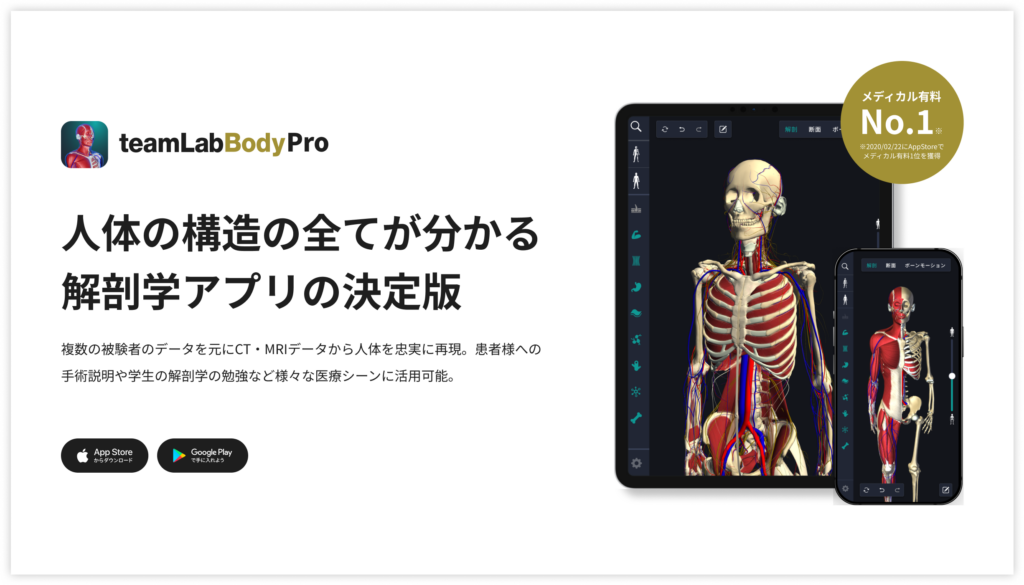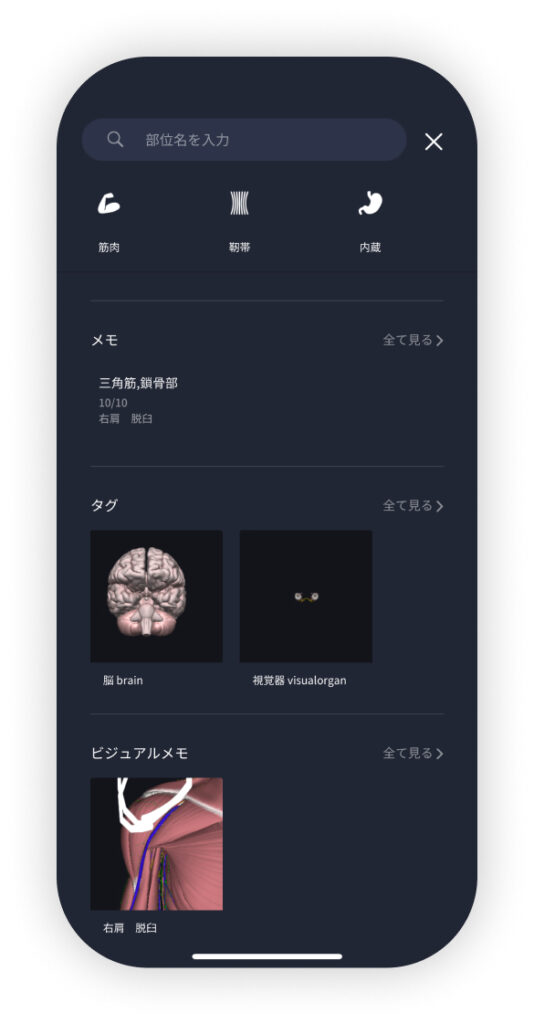beginning
In this article, I will explain effective study methods, starting with knowledge of specialized parts in human anatomy.
In human anatomy, it is necessary not only to memorize the names of various organs, muscles, and bones, but also to remember where they are located in the body. Therefore, it is necessary to learn as efficiently as possible.
I hope you can read this article and use the app to deepen your understanding even a little bit.
Now, I'll explain the details about the “palmar finger artery” and how to study human anatomy.
teamLab Body Pro Free Download
A 3D anatomy app that shows all the structures of the human body
Download teamLab Body Pro here!

What is the palmar leadership vein?
In the anatomy application, you can view a selection of anatomy 3D models. In this model, there are various observation methods such as surfaces, cross-sections, and nervous systems. This time, I'll explain using an anatomy application.
About palmar finger artery

The palmar digital arteries (palmar digital arteries) are arteries distributed in the palm of the hand (palmar side) and are responsible for the main blood supply to the fingers. These arteries mainly branch from the superficial palmar arch and deep palmar arch. The common palmar finger artery branches from the superficial palmar arch, which further divides into the intrinsic palmar finger artery at the base of the finger and runs along both sides of each finger. The smaller palmar middle manual vein branches from the deep palmar arch and may anastomosis with the common palmar finger artery. These arteries are responsible for supplying oxygen and nutrients to various tissues such as finger bones, joints, tendons, muscles, and skin. In particular, it maintains blood flow, which is essential for finger movement and sensory function. As it moves towards the end of the finger, it branches finely and forms an abundant network of blood vessels to ensure blood flow necessary for the fine function of the fingertips. Anatomically, as part of a complex hand vascular network, its structure and function are closely related.
Study points
Location and structure of palmar finger artery
The palmar digital arteries (palmar digital arteries) are arteries located in the palm of the hand (palm side) and are responsible for supplying blood flow to the fingers. These arteries mainly branch from the arterial arch located in the palm of the hand. Specifically, the common palmar finger artery branches from the superficial palmar arch, which further divides into the intrinsic palmar finger artery at the base of the finger and runs on the side of each finger. Also, from the deep palmar artery arch, the thinner palmar middle manual vein branches and may anastomosis with the common palmar finger artery. Structurally, these arteries run along the long axis of the finger to supply oxygen and nutrients to tissues such as finger bones, joints, tendon sheaths, muscles, and skin, and branch finely as they move towards the end to form a rich vascular network. This ensures stable blood flow, which is necessary for the delicate function of the fingertips. Anatomically, as part of the hand's complex vascular system, its position and branching pattern are closely related to finger function.
The role and function of the palmar finger artery
The main function and function of the palmar digital arteries (palmar digital arteries) is to supply blood to each tissue in the finger. These arteries branch from the artery arch in the palm of the hand and carry oxygen and nutrients to a wide range of tissues such as finger bones, joints, tendons, muscles, and skin. Thus, metabolism necessary for vital activity such as finger movement and sensory function is maintained. Specifically, the common palmar finger artery branches into the proper palmar finger artery at the base of the finger, and while running on the side of each finger, it sends its thin branches to surrounding tissues. This abundant branching and the formation of a fine vascular network ensures stable blood flow necessary for the delicate function of the fingertips. Anatomically, the palmar finger artery functions as the final arterial blood supply channel to the periphery in the complex vascular network of the hand. By efficiently distributing blood to various tissues in the finger while cooperating with the deep artery arch, it is a foundation that supports precise movement and tactile sensation of the hand.
English notation for palmar finger artery
The English notation for palmar finger artery is “palmar digital arteries.” This name clearly indicates its anatomical location and characteristics. “Palmar” is an adjective with the meaning of “palm of the hand, on the palm side,” and it indicates that this artery is located on the palm side of the hand. This is often contrasted with “plantar (plantar),” which indicates the bottom of the foot, and is important for accurately identifying parts of the body. “Digital” is an adjective with the meaning of “finger,” and is derived from the noun “digit (finger),” indicating that this artery is a blood vessel that supplies blood to the finger. “arteries” is the plural form of the noun “artery,” which means “artery.” Since arteries run through multiple fingers, they are expressed in the plural form. By combining these words, the position and function of the “finger artery in the palm of the hand” is accurately expressed. In medical terminology, it is common for each element to be composed of words with specific meanings, and the structure is useful for identifying parts.
How to study human anatomy
I will explain specific study methods using human anatomy applications.
Check your past learning history and practice repeatedly
Here are the steps to check your anatomy learning history and practice iteratively effectively.
1. Check your learning history in the app
Reviewing your learning history with the application is an important step in effectively advancing anatomy learning. First, launch the app and go to the learning history section from the main menu. Many anatomy apps are designed to show your progress in the form of graphs and lists, so you can visually check which parts you've learned about and how much time you've spent.
By using this data, you can understand which areas you have strengths in and where you need to spend more time and effort. We also recommend using a dedicated tag or notebook function to mark areas you are particularly weak at or where you need to relearn. Regularly checking your learning history and looking back on past learning content will lead to efficient review and deepening understanding.
2.Make a plan for iterative learning
Making an efficient repetitive learning plan based on learning history is extremely effective in promoting knowledge retention. First, identify weak points and areas where you need to relearn. Next, arrange these study items into a weekly or monthly calendar and create a specific study schedule. By proceeding in a planned manner, you can learn each part evenly and avoid packing in a large amount of information at once.
Using a task management app or digital calendar to set study reminders is effective. Also, it's important to have the flexibility to regularly review progress and revise plans as needed. By having goals and proceeding with your studies in a planned manner, you can efficiently acquire anatomical knowledge.
3.Use 3D features to learn visually
By utilizing the 3D function, learning anatomy is easier to understand visually. The 3D model shows the structure of the human body three-dimensionally, and each part can be observed in detail. This makes it possible to intuitively grasp positional relationships between deep muscles and organs that are difficult to capture in a planar view. For example, you can learn even the smallest details by rotating specific muscles and bones and zooming in and out.
Also, there are many apps that have the function of displaying cross-sectional views of each part using a 3D model, which is useful for deepening understanding of internal structures. This diversity of visual information helps with memory retention and improves immediate responsiveness in tests and practice situations. By utilizing the 3D function and learning visually, you can learn anatomy knowledge more deeply and efficiently.
Use the memo function concretely

Make notes so you don't forget the things and points you've noticed while studying. The memo function can be used for different purposes, such as inputting text, saving images, and writing memos. Tag your notes to make them easier to review later.
Test your learning regularly in the form of quizzes
Regularly testing what you've learned in a quiz format is a very effective way to anchor your anatomy knowledge. Quiz-style tests help you objectively grasp your level of understanding and areas you lack while repeating knowledge.
For example, by using a learning app to conduct quizzes every specific period, you can reconfirm what you've learned and strengthen your memory. There are a wide range of quiz formats, such as multiple choice questions, fill-in-the-blank questions, and short answer questions, and each helps understanding from a different angle and develops the ability to utilize various types of knowledge.
Get feedback
If possible, get feedback from other learners and experts. It helps you find your own gaps in understanding and areas for improvement. You can also keep yourself motivated to learn by regularly testing yourself. Feeling a sense of accomplishment and progress increases motivation for continuous learning.
summary
This time, I explained how to study the “palmar finger artery” using an application!
Thank you for reading this far.
I would be happy if reading this article helped you learn about anatomy.
Learning is a long, never-ending journey, but I sincerely wish you all the best. Let's continue to study together and work hard for the national exam!
Please look forward to the next blog.




